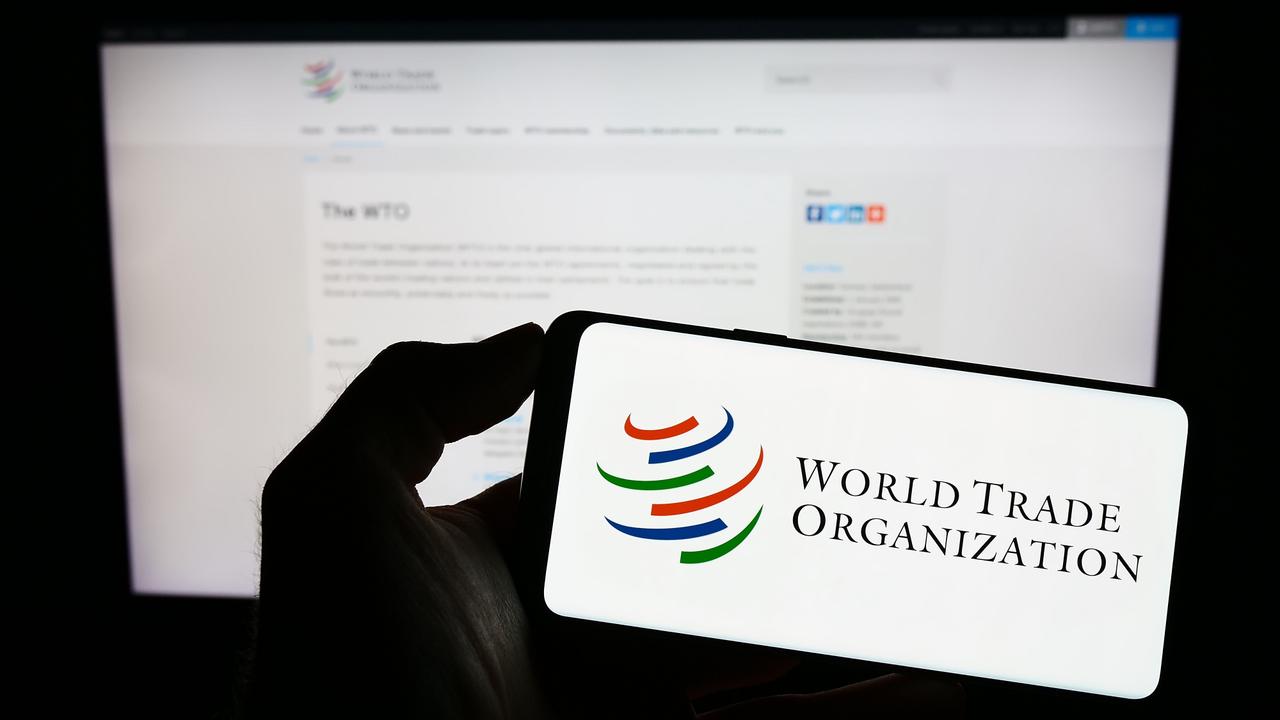AI-Related Goods Drive Unexpected Surge in Global Trade, WTO Reports
3 Sources
3 Sources
[1]
Las mercancías relacionadas con la IA, y las operaciones anticipadas mejoran las expectativas del comercio mundial en 2025; sin embargo, las perspectivas para 2026 son poco alentadoras.
In the 7 October update of "Global Trade Outlook and Statistics", WTO economists provide new analysis on the build-up in inventories in 2025 and the robust trade in artificial intelligence-related goods such as semiconductors, servers and telecommunications equipment. They note however that trade growth will likely slow in 2026 as the impact of the cooling global economy and new tariffs set in. Director-General Ngozi Okonjo-Iweala said: "Countries' measured response to tariff changes in general, the growth potential of AI, as well as increased trade among the rest of the world--particularly among emerging economies--helped ease trade setbacks in 2025," noting that South-South trade grew 8% year-on-year, in value terms, in the first half of 2025, compared to 6% for world trade overall. South-South trade involving partners other than China is growing even faster, up around 9%. "Trade resilience in 2025 is thanks in no small part to the stability provided by the rules-based multilateral trading system. Yet complacency is not an option. Today's disruptions to the global trade system are a call to action for nations to reimagine trade and together lay a stronger foundation that delivers greater prosperity for people everywhere," DG Okonjo-Iweala said. The volume of world merchandise trade, as measured by the average of exports and imports, grew 4.9% year-on-year in the first half of 2025. The value of world merchandise trade in current US dollar terms was up 6% year-on-year in the first six months of 2025 following a 2% increase in 2024. Trade growth drivers in the first half included the frontloading of imports in North America and favourable macroeconomic conditions such as disinflation, supportive fiscal policies, and strong growth in emerging markets. Industry reports, including purchasing managers' indices (PMIs) and national statistics, show rising inventories, with inventories-to-sales ratios in North America increasing in the first half of 2025 across sectors like machinery, motor vehicles, lumber, construction equipment, and non-durable goods AI-related goods -- including semiconductors, servers, and telecommunications equipment -- drove nearly half of the overall trade expansion in the first half of the year, rising 20% year-on-year in value terms. Trade growth spanned the digital value chain, from raw silicon and specialty gases to devices powering cloud platforms and AI applications. Asia's export performance was strong in AI-related products, consistent with the worldwide surge in investment in this sector. Higher tariff rates and elevated trade policy uncertainty are set to eventually unwind some of the effects of earlier frontloading. Already, rising input prices and a slowdown in trade shipments suggest inflation could increase in late 2025 as inventories shrink in tariff-affected, highly-exposed sectors. With higher tariffs taking effect in August, some of the impacts projected in the WTO Secretariat's April 2025 forecast are now likely to materialize later in the year and into 2026. World merchandise trade volume growth is expected to slow from 2.8% in 2024, to 2.4% in 2025 and 0.5% in 2026. The projection for global GDP growth is 2.7% for 2025 and 2.6% for 2026. While the 2025 merchandise trade forecast has been revised upwards from the April and August projections, the downgrade for 2026 results in a similar overall impact over the two-year horizon. This indicates that the tariff impact has shifted into 2026, with the slight improvement reflecting that some inventory build up in early 2025--particularly of durable goods--will not be fully reversed in 2026. WTO economists highlight that the key downside risk to the forecast is the spread of trade-restrictive measures and policy uncertainty to more economies and sectors. On the upside, sustained growth in trade for AI-related goods and services could provide a medium-term boost to global trade. Asia and Africa are expected to record the fastest export volume growth in 2025, with modest performances also anticipated from South and Central America the Caribbean and the Middle East, while Europe will likely see slower growth. North America and the Commonwealth of Independent States (CIS) face declining exports. Least-developed countries (LDCs) are expected to show robust export gains but face weakening trends ahead. On the import side, Africa and LDCs are set to experience the fastest growth, contrasting with a contraction in North America. In 2026, only North America, Europe and CIS will post an improvement in export performance; all regions will record weaker import performance in 2026. WTO economists' forecast for world commercial services trade in volume terms has also been revised taking into account current GDP and merchandise trade forecasts. Services export growth is now expected to slow from 6.8% in 2024 to 4.6% in 2025 and 4.4% in 2026. These estimates are slightly stronger than the April forecast which took account of the impact of tariffs, but still weaker than what would have been expected without the new tariffs. Although not directly subject to tariffs, services trade can be affected indirectly though links to goods trade and output. The reduced outlook for 2025 reflects weaker expected growth in Transport (2.5%, down from 4.5% in 2024) and Travel (3.1%, down from 11% last year due to post-pandemic recovery). Growth in the category Other commercial services should only be slightly weaker in 2025 than in 2024 (5.8% compared to 6.3%), but digitally delivered services should be marginally stronger (6.1% compared to 5.7%). For 2026, growth in transport services is expected to be slower at 1.8%, reflecting the deteriorating outlook for merchandise trade. Meanwhile, travel growth should pick up slightly to 4.4%, while growth should remain mostly stable in Other commercial services (5.1%) and digitally delivered services (5.6%). Europe is expected to have the fastest services export growth in 2025, followed by Asia, the Middle East, and CIS. North America is projected to see moderate growth, while South and Central America and the Caribbean and Africa will experience the slowest expansions. In 2026, projections are mixed: services exports of Asia and Africa expected to accelerate while Europe, CIS and the Middle East will see a deceleration. North America and South and Central America and the Caribbean will see services exports growth holding steady. The report also provides an analysis of trade imbalances and limits of trade policy. The full report is available here. Detailed annual, quarterly and monthly trade statistics can be downloaded from the WTO Stats portal. A new interactive tool providing monthly merchandise trade data for over 120 economies, more than 70 product categories and 200 trading partners covering the period January 2018 to August 2025 is available on the WTO Tariff and Trade Data portal.
[2]
WTO Says AI-Related Buying Binge and a Spike in US Imports Spur Unexpected Rise in Goods Trade
Nigeria's Ngozi Okonjo-Iweala, Director General of the World Trade Organisation (WTO), speaks to the media about the report "Global Trade Outlook and Statistics - October 2025 update", during a press conference at the headquarters of the World Trade Organization (WTO) in Geneva, Switzerland, Tuesday, Oct. 7, 2025. (Salvatore Di Nolfi/Keystone via AP) GENEVA (AP) -- The World Trade Organization is sharply raising its forecast for trade growth in goods this year after an unexpectedly strong first half due to rising AI-related purchases, front-loaded imports in the U.S. over tariff fears and robust developing-world trade. The Geneva-based trade body said Tuesday its economists are increasing their prediction of growth in merchandise trade to 2.4% this year, up from 0.9% as recently as August. In April, WTO experts were actually anticipating a decline of goods trade this year of 0.2% However, they're lowering the prediction for 2026 to 0.5%, from 1.8%. The growth of export in services, meanwhile, is expected to come in at 4.6% in 2025 and 4.4% next year -- both slower rates than the 6.8% tallied in 2024. WTO pointed to "robust trade in artificial intelligence-related goods" that are driving the increase in merchandise trade, notably semiconductors, servers and telecommunications equipment. Director-General Ngozi Okonjo-Iweala suggested solid trade growth among developing countries and a cool-headed reaction to sweeping -- and often-varying -- tariffs announced by the Trump administration earlier this year had underpinned the gains. "Countries' measured response to tariff changes in general, the growth potential of AI, as well as increased trade among the rest of the world -- particularly among emerging economies -- helped ease trade setbacks in 2025," she said. Despite "strong headwinds," Okonjo-Iweala said trade has shown resilience because of "importers front-loading orders to get ahead of future tariff hikes or retaliation." U.S. inventories are at record levels by dollar value, and the value of North America's imports surged 13.2% at an annual rate, driven by pharmaceuticals and precious metals -- mostly gold. She also attributed the gains to "soaring demand" for AI-related products behind a capital investment boom. A staggering 42% of global trade growth came from AI-related goods, she said, much higher than their 15% share in world trade. South-South trade -- among developing countries -- grew 8% year-on-year in value terms in the first half of the year, while such trade involving partners other than China is growing at around 9%, WTO said.
[3]
WTO Says AI-Related Goods Drove 43% of Global Trade Growth in First Half | PYMNTS.com
By completing this form, you agree to receive marketing communications from PYMNTS and to the sharing of your information with our sponsor, if applicable, in accordance with our Privacy Policy and Terms and Conditions. While AI-related products account for 15% of global imports and exports, they made up 43% of global trade growth, the WTO said in its latest Global Trade Outlook and Statistics. The trade in these goods, which include semiconductors, servers, telecommunications equipment and about 100 other product lines, rose nearly 20% year over year to reach $1.92 trillion during the first half, according to the report. During the same period, trade in non-AI goods grew by less than 4%, per the report. "By the second quarter of 2025, much of the momentum for AI-related trade had shifted beyond the United States," the report said. "Other economies accounted for close to 40% of global AI-related trade growth, with Asian suppliers and emerging markets playing an increasingly prominent role." "This reinforces the view that the expansion of AI-related trade is not entirely driven by recent trade policy developments but represents a broader structural wave of investment in digital infrastructure," the report said. The WTO said in September that with the right policies in place, AI could increase the value of cross-border flows of goods and services by nearly 40% by 2040, due to productivity gains and lower trade costs. The organization said these policies would include targeted investment in education and training as well as inclusive policies. Overall, the volume of world merchandise trade grew 4.9% year over year in the first half, the WTO said in a Tuesday press release highlighting findings from the latest Global Trade Outlook and Statistics report. Together with AI-related goods, other drivers of growth included North American businesses stocking up on imported goods ahead of the implementation of tariffs as well as favorable macroeconomic conditions like disinflation, supportive fiscal policies and growth in emerging markets, according to the release. Due to these factors, global merchandise trade "outpaced expectations" in the first half, the release said. This led WTO economists to raise their forecast for 2025 merchandise trade growth to 2.4%, up from their forecast of 0.9% in August. "Countries' measured response to tariff changes in general, the growth potential of AI, as well as increased trade among the rest of the world -- particularly among emerging economies -- helped ease trade setbacks in 2025," WTO Director-General Ngozi Okonjo-Iweala said in the release.
Share
Share
Copy Link
The World Trade Organization (WTO) reports a significant increase in global trade, largely driven by AI-related goods. Despite this growth, the organization forecasts a slowdown in 2026 due to economic cooling and new tariffs.
AI Boom Fuels Unexpected Trade Growth
The World Trade Organization (WTO) has reported a surprising surge in global trade, largely driven by artificial intelligence (AI) related goods. In its October 2025 update of the "Global Trade Outlook and Statistics," WTO economists revealed that AI-related products accounted for nearly half of the overall trade expansion in the first half of the year
1
3
.
Source: WTO
The trade in AI-related goods, including semiconductors, servers, and telecommunications equipment, rose by an impressive 20% year-on-year in value terms
1
. This growth spanned the entire digital value chain, from raw materials to devices powering cloud platforms and AI applications.Revised Forecasts and Economic Indicators
In light of these developments, the WTO has significantly revised its trade growth forecasts. The organization now expects world merchandise trade volume to grow by 2.4% in 2025, up from the 0.9% projected in August
2
. However, the outlook for 2026 remains cautious, with growth expected to slow to 0.5%1
.The volume of world merchandise trade grew by 4.9% year-on-year in the first half of 2025, while the value increased by 6% in current US dollar terms
1
. This growth was supported by various factors, including frontloading of imports in North America and favorable macroeconomic conditions such as disinflation and supportive fiscal policies.Regional Trade Dynamics and South-South Growth
The WTO report highlighted significant regional variations in trade performance. Asia and Africa are expected to record the fastest export volume growth in 2025, while Europe is likely to see slower growth. North America and the Commonwealth of Independent States (CIS) face declining exports
1
.A notable trend is the robust growth in South-South trade, which increased by 8% year-on-year in value terms during the first half of 2025, outpacing the overall world trade growth of 6%
2
. South-South trade excluding China grew even faster, at around 9%.Related Stories
Challenges and Future Outlook
Despite the positive trends, the WTO warns of potential challenges ahead. The implementation of new tariffs and elevated trade policy uncertainty are expected to impact trade growth negatively in late 2025 and into 2026
1
.WTO Director-General Ngozi Okonjo-Iweala emphasized the importance of the rules-based multilateral trading system in maintaining trade resilience. She called for nations to "reimagine trade and together lay a stronger foundation that delivers greater prosperity for people everywhere"
1
.
Source: PYMNTS
As the global economy navigates these complex trade dynamics, the sustained growth in AI-related goods and services could provide a medium-term boost to global trade, potentially offsetting some of the anticipated slowdowns in other sectors.
References
Summarized by
Navi
[2]
Related Stories
AI Set to Revolutionize Global Trade, WTO Report Predicts 40% Growth by 2040
17 Sept 2025•Business and Economy

WTO Report Highlights AI's Transformative Impact on Global Trade
21 Nov 2024•Business and Economy

Global Services Trade Growth Slows in Q1 2025, with AI-Driven Computer Services Showing Resilience
01 Aug 2025•Business and Economy

Recent Highlights
1
Google launches Gemini 3 Flash as default AI model, delivering speed with Pro-grade reasoning
Technology

2
OpenAI launches GPT Image 1.5 as AI image generator war with Google intensifies
Technology

3
OpenAI launches ChatGPT app store, opening doors for third-party developers to build AI-powered apps
Technology





